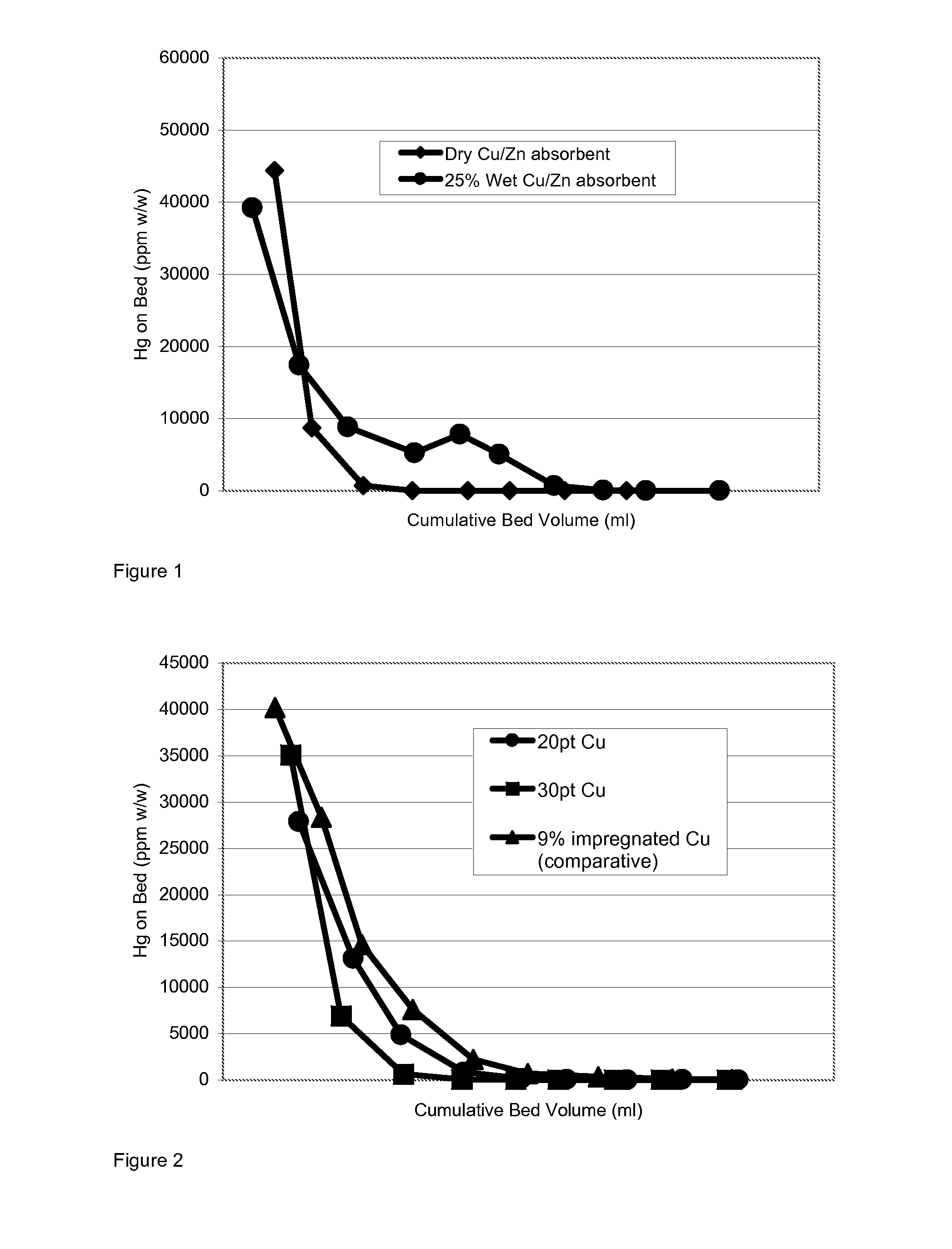Absorbents
a technology of absorbents and absorbents, applied in the field of absorbents, can solve the problems of reduced mercury capacity, inability to increase pressure drop, difficult and long discharge of absorbents from absorption vessels, etc., and achieve the effect of reducing mercury capacity
- Summary
- Abstract
- Description
- Claims
- Application Information
AI Technical Summary
Benefits of technology
Problems solved by technology
Method used
Image
Examples
example 1
Comparative
[0049]In order to assess the problems caused when water is present, 25 ml of a 1-2 mm-sized particulate granulated absorbent comprising sulphided copper and zinc compounds, alumina support and single cement binder was charged to a tubular lab-scale absorption vessel (i.d. 18 mm). The copper content of the sulphided absorbent was 45% wt (as oxide) and the zinc content was 22% wt (as oxide).
[0050]The lower 25 wt % by volume of the bed was made up from a pre-soaked absorbent. The material was immersed in demineralised water for 30 minutes at ambient temperature, then the water was decanted off and the particles touch-dried with absorbent paper. The remaining upper 75% by volume of the bed was dry material. N-hexane saturated with elemental mercury to ca. 1 ppm (w / v) was passed upwards through the bed at ambient temperature (about 20° C.) such that the fluid contacted the water-soaked material and then the dry material, at a Liquid Hourly Space Velocity (LHSV) of 7.0 hr−1 for...
example 2
Dry Testing
[0056]Absorbent precursor compositions were prepared in a granulator with the following compositions;[0057]20 or 30 parts by weight of a flash-dried copper hydroxycarbonate,[0058]80 or 70 parts by weight of alumina trihydrate,[0059]14 parts by weight of binders comprising 10 parts of a calcium aluminate cement having a CaO content of about 40% wt, plus 4 parts Attapulgite clay).
[0060]The granules were dried at 105° C. in air for 16 hours after a period of 2 hours at ambient temperature (ca 20° C.). The size range of granules obtained was 1-5 mm.
[0061]The granulated materials were sulphided in the laboratory to saturation in 1% H2S to generate the active absorbent.
[0062]The sulphided absorbents were run in the test as described in Example 1, although the beds in each case were run dry and not pre-soaked. The test was repeated on a commercially available pre-sulphided 9% wt Cu (as oxide) impregnated alumina absorbent. The results are depicted in FIG. 2. The results show tha...
example 3
Wet Testing
[0063]An absorbent precursor composition was prepared in a granulator with the following composition;[0064]25 parts by weight of a flash-dried copper hydroxycarbonate,[0065]75 parts by weight of alumina trihydrate,[0066]14 parts by weight of binders comprising 10 parts of a calcium aluminate cement having a CaO content of about 40% wt, plus 4 parts Attapulgite clay).
[0067]The granules were dried at 105° C. in air for 16 hours after a period of 2 hours at ambient temperature (ca 20° C.). The size range of granules obtained was 1-5 mm.
[0068]The granulated materials were sulphided in the laboratory to saturation in 1% H2S to generate the active absorbent.
[0069]The sulphided absorbent was run as tested in Example 1 with the first 25% vol of the bed pre-soaked in demineralised water. The test was repeated on a commercially available presulphided 9% wt Cu (as oxide) impregnated alumina absorbent, again with the first 25% of the bed pre-soaked. The results are depicted in FIG. 3...
PUM
| Property | Measurement | Unit |
|---|---|---|
| particle size | aaaaa | aaaaa |
| particle size | aaaaa | aaaaa |
| particle size | aaaaa | aaaaa |
Abstract
Description
Claims
Application Information
 Login to View More
Login to View More - R&D
- Intellectual Property
- Life Sciences
- Materials
- Tech Scout
- Unparalleled Data Quality
- Higher Quality Content
- 60% Fewer Hallucinations
Browse by: Latest US Patents, China's latest patents, Technical Efficacy Thesaurus, Application Domain, Technology Topic, Popular Technical Reports.
© 2025 PatSnap. All rights reserved.Legal|Privacy policy|Modern Slavery Act Transparency Statement|Sitemap|About US| Contact US: help@patsnap.com



